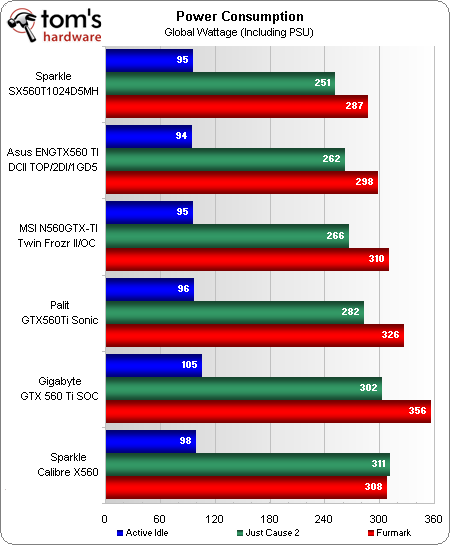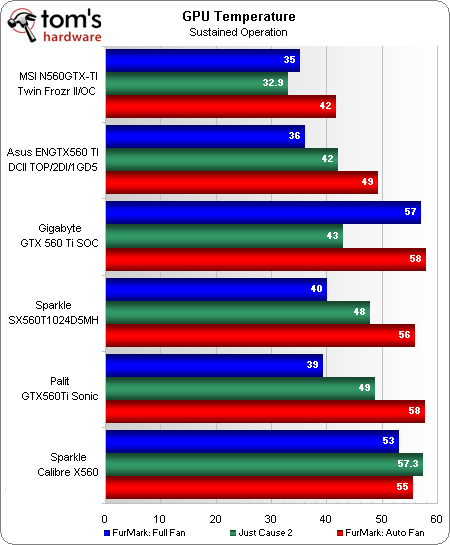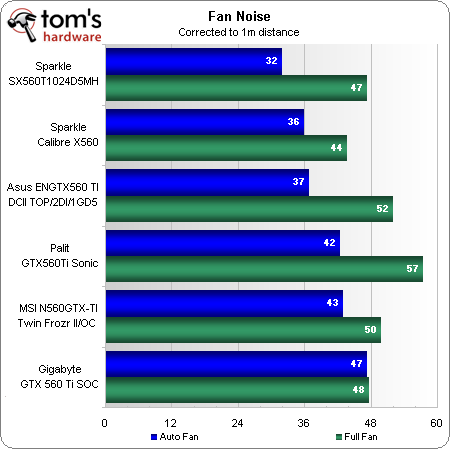Five Overclocked GeForce GTX 560 Ti Cards, Compared
We gave the GeForce GTX 560 Ti a thorough evaluation at launch. But Nvidia was perhaps most excited about some of its partners were doing with GF114. And so, we set out to find customized boards. Our search lead to five factory-overclocked alternatives.
Power, Heat, and Noise
Both Nvidia and AMD hate artificial stress tests like FurMark, and have initiated workarounds that allow the graphics card to downclock whenever the GPU exceeds amperage limits or thermal specifications. While some editors believe that this is a good thing for increasing GPU capability, this editor believes the same technology can cause “frame rate inflation” in actual games. The reason of course is that if a game were capable of pushing the GPU’s limit (an admittedly hypothetical scenario), FPS would only drop during the tough parts of the map—where the extra performance most needed.
Rather than drop FurMark completely, we added Just Cause 2 to today’s power tests. Because the game does not generate a consistent load, its charted numbers represent the highest power level held for at least three seconds.
Sparkle’s Calibre X560 appears to be the most affected by Nvidia’s overcurrent protection scheme, which is an entirely optional inclusion on GeForce GTX 560 Ti cards, drawing more power than its Gigabyte competitor under Just Cause 2 but less than that same competitor under FurMark. The reason for that discrepancy can likely be tracked to the voltage regulator itself, since Sparkle uses Nvidia’s reference design while Gigabyte has its own. Looking at the game leaves little room for interpretation. The Calibre X560’s slightly-higher power use in Just Cause 2 is most likely due to its memory overclock.
Asus appears most-miserly of the three middle cards, coming in 20 W lower than the same-speed Palit product.
The same scenario that played out in the power tests is also seen in the GPU temperature chart, at least when automatic fan control is used. Gigabyte’s “full fan” results appear less-impressive because the card was already pushing 89% fan speed under “auto fan” mode with FurMark.
Looking at the fan capacity of the middle cards, MSI barely edges out Asus with a card that’s clocked 20 MHz slower, while Palit falls behind.
Now that we know that FurMark results apply to every card except the Calibre X560, the only question was how we could accurately test full-load fan noise. The only application we have that can maintain full GPU load until temperature remains constant is FurMark, so we pressed on, knowing that only the Calibre X560’s results would be invalid.
Get Tom's Hardware's best news and in-depth reviews, straight to your inbox.
The rest of the chart reveals that Asus beats Palit in noise as well as cooling, and that Gigabyte’s fans have a relatively-low maximum speed.
Current page: Power, Heat, and Noise
Prev Page Benchmark Results: S.T.A.L.K.E.R.: Call Of Pripyat Next Page Conclusion-
Please add in the results idle noise level. For me, noise is one of the most important thing when considering a graphics card. I bought a Galaxy GTX 460 last year with the funny cooler and it sounded like a jet engine even when idle. I ended up replacing it with a Thermalright Shaman cooler, the 140mm fan is much more pleasant to the ears.Reply
-
Annisman Thanks for the review, any news on any *new* 2GB models of the GTX 560 ? The only one currently available is the Palit version, which shares the same design as the Palit sonic edition card that was reviewed. Would love to see a Gigabyte SOC 2GB card...Reply -
ScoobyJooby-Jew These are some pretty sweet cards. Could you put up the numbers for a reference spec GTX 470. That would be interesting to see how they compare performance wise. The OC'ed cards have pretty similar bandwith to the 470. The big powerful 320 bit card vs the smaller more efficient 256 bit card.Reply -
ScoobyJooby-Jew There should have been a please in the previous post, and a question mark. -1 for bad grammar. -1 for bad manners.Reply -
mattmock I am not sure that even dual GTX 580s qualify as a status symbol. They sit in your computer and no one ever sees them.Reply -
nebun MattMockI am not sure that even dual GTX 580s qualify as a status symbol. They sit in your computer and no one ever sees them.you don't need to see it...you only need to feel it...wait, it's still in the case...lolReply -
gti88 Well, one still need to overclock to play Crysis. But who cares, when Crysis 2 is in the wild?Reply -
iam2thecrowe Why dont your roundups ever contain reference to other cards???? Please, reference to other cards. If the most overclocked card costs nearly as much as a gtx570, you need to show the speed difference of similarly priced cardsReply -
utengineer iam2thecroweWhy dont your roundups ever contain reference to other cards???? Please, reference to other cards. If the most overclocked card costs nearly as much as a gtx570, you need to show the speed difference of similarly priced cardsThis was not the intent of the article. This article was intended to see which 560Ti was the best bang for your buck. I am sure there will be future articles that compare different cards and their price points.Reply
-
hardcore_gamer gti88Well, one still need to overclock to play Crysis. But who cares, when Crysis 2 is in the wild?Even a 8800GT can play Crysis 2.We have to change our spam to " can it play Crysis 1 ? "Reply



